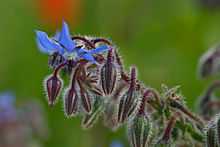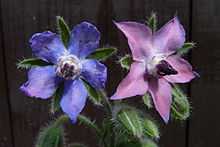Borage
.
| Borage | |
|---|---|
 | |
| Borage flower | |
| Scientific classification | |
| Kingdom: | Plantae |
| (unranked): | Angiosperms |
| (unranked): | Eudicots |
| (unranked): | Asterids |
| Order: | (unplaced) |
| Family: | Boraginaceae |
| Genus: | Borago |
| Species: | B. officinalis |
| Binomial name | |
| Borago officinalis L. | |
Borage (/ˈbɒr.ɪdʒ/, Borago officinalis), also known as a starflower, is an annual herb. It is native to the Mediterranean region and has naturalized in many other locales. It grows satisfactorily in gardens in the UK climate, remaining in the garden from year to year by self-seeding. The leaves are edible and the plant is grown in gardens for that purpose in some parts of Europe. The plant is also commercially cultivated for borage seed oil extracted from its seeds.
Appearance
It grows to a height of 60–100 cm (2.0–3.3 ft), and is bristly or hairy all over the stems and leaves; the leaves are alternate, simple, and 5–15 cm (2.0–5.9 in) long. The flowers are complete, perfect with five narrow, triangular-pointed petals. Flowers are most often blue in color, although pink flowers are sometimes observed. White flowered types are also cultivated. The blue flower is genetically dominant over the white flower.[1] The flowers arise along scorpioid cymes to form large floral displays with multiple flowers blooming simultaneously, suggesting that borage has a high degree of geitonogamy (intra-plant pollination).[1] It has an indeterminate growth habit which may lead to prolific spreading. In temperate climate such as in the UK, its flowering season is relatively long, from June to September. In milder climates, borage will bloom continuously for most of the year.
Characteristics and uses


Traditionally borage was cultivated for culinary and medicinal uses, although today commercial cultivation is mainly as an oilseed. The seed oil is desired as source of gamma-linolenic acid (GLA), for which borage is the highest known plant-based source (17-28%).[2] The seed oil content is between 26-38% and in addition to GLA contains the fatty acids palmitic acid (10-11%), stearic acid (3.5-4.5%), oleic acid (16-20%), linoleic acid (35-38%), eicosenoic acid (3.5-5.5%), erucic acid (1.5-3.5%), and nervonic acid (1.5%). The oil is often marketed as "starflower oil" or "borage oil" for uses as a GLA supplement, although healthy adults will typically produce ample GLA through dietary linoleic acid.
Borage is used as either a fresh vegetable or a dried herb. As a fresh vegetable, borage, with a cucumber-like taste, is often used in salads or as a garnish.[3] The flower, which contains the non-toxic pyrrolizidine alkaloid (PA) thesinine, has a sweet honey-like taste and is one of the few truly blue-colored edible substances, is often used to decorate desserts.[3] It is notable that the leaves have been found to contain small amounts (2-10 ppm of dried herb) of the liver-toxic PAs intermedine, lycopsamine, amabiline and supinine.[4] Leaves contain mainly the toxic lycopsamine also amabiline and the non-toxic saturated PA thesinine. PAs are also present in borage seed oil, but may be removed depending on method of processing.[5][6][7][8][9][10]
Vegetable use of borage is common in Germany, in the Spanish regions of Aragón and Navarra, in the Greek island of Crete and in the northern Italian region of Liguria. Although often used in soups, one of the better known German borage recipes is the Green Sauce (Grüne Soße) made in Frankfurt. In Italian Liguria, borage is commonly used as a filling of the traditional pasta ravioli and pansoti. It is used to flavour pickled gherkins in Poland.
Borage is also traditionally used as a garnish in the Pimms Cup cocktail,[3] but is nowadays often replaced by a long sliver of cucumber peel or by mint. It is also one of the key "Botanical" flavourings in Gilpin's Westmorland Extra Dry Gin.
Traditional and modern medicine
A methanol extract of borage has shown strong amoebicidal activity in vitro. The 50% inhibitory concentration (LD50) of the extract for Entamoeba histolytica was only 33 µg/mL.[11]
Traditionally Borago officinalis is used in hyperactive gastrointestinal, respiratory and cardiovascular disorders,[12] such as gastrointestinal (colic, cramps, diarrhea), airways (asthma, bronchitis), cardiovascular, (cardiotonic, antihypertensive and blood purifier), urinary (diuretic and kidney/bladder disorders).[13]
In Iran people make a tea to relieve colds, flu, bronchitis, rheumatoid arthritis, and kidney inflammation. It is said to be warm in nature and alleviates symptoms that are caused by using food that is cold in nature such as cucumber and fish. People with heart problems can benefit using the borage tea, since it promotes better circulation of oxygen to the heart; that’s why one should use this herb in moderate amounts.[14]
Naturopathic practitioners use borage for regulation of metabolism and the hormonal system, and consider it to be a good remedy for PMS and menopause symptoms such as the hot flash.[15] The flowers can be prepared in infusion.
One case of status epilepticus has been reported that was associated with borage oil ingestion.[16]
Companion planting
Borage is used in companion planting.[17] It is said to protect or nurse legumes, spinach, brassicas, and even strawberries.[18] It is also said to be a good companion plant to tomatoes because it confuses the search image of the mother moths of tomato hornworms or manduca looking for a place to lay their eggs.[19] Claims that it improves tomato growth[20] and makes them taste better[21] remain unsubstantiated.
See also
References
- ↑ 1.0 1.1 "Geitonogamy: a mechanism responsible for high selfing rates in borage (Borago officinalis L.) - Springer" (PDF). Springerlink.com. Retrieved 2013-09-13.
- ↑ National Non-Food Crops Centre. NNFCC Crop Factsheet: Borage, Retrieved on 16 Feb 2011
- ↑ 3.0 3.1 3.2 "Borage". Encyclopedia of spices. The Epicentre. 2009. Retrieved 2010-12-01.
- ↑ "Borage Wildflower Finder". Wildflowerfinder.org.uk. Retrieved 2013-09-13.
- ↑ Borage at Sloan-Kettering website
- ↑ Dodson, Craig D.; Stermitz, Frank R. (1986). "Pyrrolizidine alkaloids from borage (Borago officinalis) seeds and flowers". Journal of Natural Products 49 (4): 727–728. doi:10.1021/np50046a045.
- ↑ Parvais, O.; Vander Stricht, B.; Vanhaelen-Fastre, R.; Vanhaelen, M. (1994). "TLC detection of pyrrolizidine alkaloids in oil extracted from the seeds of Borago officinalis". Journal of Planar Chromatography--Modern TLC 7 (1): 80–82.
- ↑ Wretensjoe, Inger; Karlberg, Bo. (2003). "Pyrrolizidine alkaloid content in crude and processed borage oil from different processing stages". Journal of the American Oil Chemists' Society 80 (10): 963–970. doi:10.1007/s11746-003-0804-z.
- ↑ Awang V. C. (1999). Eskinazi D., ed. The Information Base for safety assessment of Botanicals. Botanical Medicine.
- ↑ Langer T., Franz Ch. (1997). "Pyrrolizidine alkaloids in commercial samples of borage seed oil products by GC-MS". Scientia Pharmaceutica 65 (4): 321–328.
- ↑ Leos-Rivas C., Verde-Star M.J., Torres L.O., Oranday-Cardenas A., Rivas-Morales C., Barron-Gonzalez M.P., Morales-Vallarta M.R., Cruz-Vega D.E.; Verde-Star; Torres; Oranday-Cardenas; Rivas-Morales; Barron-Gonzalez; Morales-Vallarta; Cruz-Vega (2011). "In vitro amoebicidal activity of borage (Borago officinalis) extract on entamoeba histolytica". Journal of Medicinal Food 14 (7–8): 866–869. doi:10.1089/jmf.2010.0164. PMID 21476887.
- ↑ Gilani A.H., Bashir S., Khan A.-u."Pharmacological basis for the use of Borago officinalis in gastrointestinal, respiratory and cardiovascular disorders". Journal of Ethnopharmacology. 114 (3) (pp 393-399), 2007.
- ↑ Gilani A.-U.-H.Focused Conference Group: P16 - Natural products: Past and future? Pharmacological use of borago officinalis. Basic and Clinical Pharmacology and Toxicology. Conference: 16th World Congress of Basic and Clinical Pharmacology - WorldPharma 2010 Copenhagen Denmark. Publication: (var. pagings). 107 (pp 301), 2010. Date of Publication: July 2010.[Journal: Conference Abstract]
- ↑ Pharmaceutical Plants: Properties of fruits and vegetables., Ed: Shahabe Khezri, ISBN 964-06-2267-2
- ↑ Gupta M., Singh S. Borago officinalis Linn. "An important medicinal plant of Mediterranean region: Review." International Journal of Pharmaceutical Sciences Review and Research. 5 (1) (pp 27-34), 2010.
- ↑ Al-Khamees W.A., Schwartz M.D., Alrashdi S., Algren A.D., Morgan B.W.; Schwartz; Alrashdi; Algren; Morgan (2011). "Status Epilepticus Associated with Borage Oil Ingestion". Journal of Medical Toxicology 7 (2): 154–157. doi:10.1007/s13181-011-0135-9. PMC 3724443. PMID 21387119. After taking 1.5 to 3g of borage oil daily for a week; level of GLA in blood was high.
- ↑ "Gardening Borage a Companion Plant". Back2theland.com. 2009-05-23. Retrieved 2013-09-13.
- ↑ Long Island Adventures LLC. "Borage: Herbal Companion". N8ture. Retrieved 2013-09-13.
- ↑ "Use Borage". Gardenguides.com. Retrieved 2013-09-13.
- ↑ "GH Organics". GH Organics. Retrieved 2013-09-13.
- ↑ "Borage Garden Guide". Gardenguides.com. Retrieved 2013-09-13.
External links
| Wikimedia Commons has media related to Borago officinalis. |
-
 "Borage". The American Cyclopædia. 1879.
"Borage". The American Cyclopædia. 1879.
- "Borage". MissouriBotanicalGarden.org.